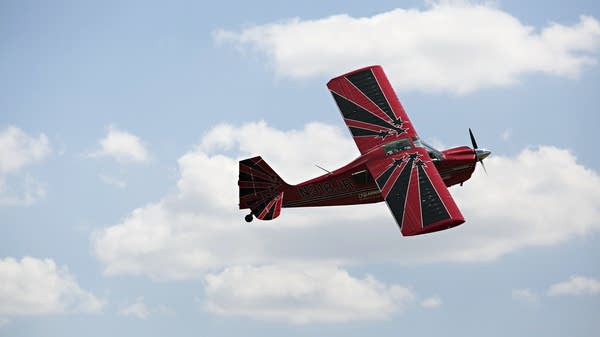High-flying UND students master gravity-defying stunts

Go Deeper.
Create an account or log in to save stories.
Like this?
Thanks for liking this story! We have added it to a list of your favorite stories.
When Michael Lents offers to take you for a spin, he is not kidding.
The head coach of the University of North Dakota aerobatics team has flown stunts for a dozen years. His teams have won eight consecutive national aerobatic championships, and they're preparing for the first competition of the new season later this month.
Lents' credentials offer some needed reassurance to a novice scrambling into his plane's backseat. You've already been fitted with a parachute and told to empty your pockets because you don't want loose change or a cellphone distracting the pilot in the middle of a gravity defying maneuver in the 1 kilometer cube of airspace you'll be flying in, known as "the box."
Then you hear someone joke about the over-under on how many airsick bags you'll fill. Too late.
Turn Up Your Support
MPR News helps you turn down the noise and build shared understanding. Turn up your support for this public resource and keep trusted journalism accessible to all.
"We are good to go," Lents calls out. "Do a final check on your seatbelt. All good? Good. Alright. Let's have some fun."

Lents starts with gentle rolls, smoothly flipping the plane 360 degrees. That seems fine. Then he asks, "Should we go vertical? We'll do what's called a hammerhead."
The plane climbs straight up until it loses speed. Then Lents pivots the plane on its wingtip and heads straight down, rolling as he dives. One second you feel weightless, then the G-forces slam you into the seat and leave you lightheaded.
After a few more loops and rolls Lents brings the plane down, safely. There is dizziness — but the passenger airsick bag goes unused. For Lents, this is just a relaxing Saturday morning.
"I think it's just fun," he said. "It's out of the normal and demands a higher level of skill and attention and detail than normal basic straight and level flying."
These maneuvers might look dangerous, but Lents calls the risk low. The planes they use — the American Champion Aircraft Corp.'s Super Decathlon — are designed for the high stress of spins and rolls.
Students fly with a seasoned aerobatic pilot in the back seat. And the pilots keep enough altitude to correct a mistake that might be deadly close to the ground.

"We're lower than the normal, but we're not air show, ribbon-cutting, let's make everyone scared low. We're up pretty high," he said. "That's kind of our key is any maneuver that we're doing we're looking at alright how much time do I have recover."
Aerobatics shows are about daring maneuvers designed to wow a crowd. Aerobatic competitions are about flying the same maneuvers with a precision that will impress expert judges.
As UND senior Alex Hunt takes off to practice his aerobatic routine, faculty adviser Joe Vacek gets ready to grade him from the ground.
"Much better. Eight," he says of the Hallock, Minn., student who's in his second year on the team. "Downgrades were for misshape on the top due to the wind. Good line in between. He must have listened up."
Students who do the best in practice will be the ones flying in competition.

"This is more fun than anything else and there's absolutely nothing I'd rather be doing," said Austin Rennard, a junior from Santa Rosa, Calif.
The 23-year-old has been flying since he was 14. Aerobatics is mostly a competition with yourself, he said, adding that aerobatic skills will make him a better pilot.
"The experience you get flying aerobatics — the precision maneuvers, the upset recoveries — it makes you way better whether you're an airline pilot whether your corporate pilot, whether you're a crop duster," he said. "Those skills everybody should have."
About a half dozen aviation schools field aerobatics teams. In addition to UND, aviation schools with active aerobatics programs include Embry-Riddle, Southern Illinois University, Air Force Academy and Kansas State University.
"There aren't many opportunities for aviation students to show off their skills and to compete directly with other schools," Vacek said. "We've come out on top eight years in a row so we're doing something right."
Lents sat in a lawn chair with a hand held radio, guiding student pilots through maneuvers in the sky overhead. Timing is key to making a series of rolls and loops look smooth.
"It requires a lot of discipline, a lot of precision and the ability to take a lot of critique to make sure all the maneuvers work out just right and are graded accordingly," he said.
Student Alex Hunt had a good practice. A couple of maneuvers need minor adjustments, but he'll be ready for the competition season.
Hunt says when he's doing aerobatics he's so focused on the stunts and the judges he doesn't think about what he's doing. But it's hard for him to contain his excitement afterward.
He hopes to make it to the national competition later this summer. Hunt said he's mostly convinced his mom that competition aerobatics is safe.
"It's a blast. I love aerobatics, I love being able to do anything in a plane that you can do. There's not really a better feeling than that. Flying is a freedom," he said. "My mom doesn't think it's as enjoyable, but I enjoy a lot."


